 | |||||||||||||||||||||||||||||||||||||||
| MobiGlas | |||||||||||||||||||||||||||||||||||||||
|---|---|---|---|---|---|---|---|---|---|---|---|---|---|---|---|---|---|---|---|---|---|---|---|---|---|---|---|---|---|---|---|---|---|---|---|---|---|---|---|
| Series | Design | ||||||||||||||||||||||||||||||||||||||
| Type | Transmission | ||||||||||||||||||||||||||||||||||||||
| ID | 14466 | ||||||||||||||||||||||||||||||||||||||
| Published | 2015-01-31 | ||||||||||||||||||||||||||||||||||||||
| Source | MobiGlas | ||||||||||||||||||||||||||||||||||||||
| In the series | |||||||||||||||||||||||||||||||||||||||
| |||||||||||||||||||||||||||||||||||||||
Note from the Chairman
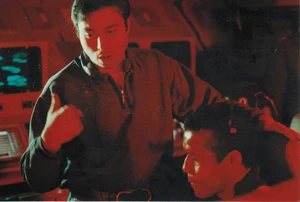
Greetings Citizens,
I’ve seen a number of questions from backers who would like to know what we are going to do about stretch goals and Chairman letters in the future. As I indicated in the last letter, I would like to celebrate the goals with increasingly in-depth design posts, one of which you find yourself reading today.
These posts take a lot more work than the average chairman letter, but I think they add quite a bit more to your knowledge of what we’re doing with Star Citizen. And as with every aspect of the game, crowd funding means that we can do them right rather than fast. Going forward, we hope to have one for you roughly every other week.
And before you think I’m just trying to get out of my correspondence, we will also have a monthly ‘Letter from the Chairman’ where I can celebrate Star Citizen’s backers, poll you on important questions and let you know what’s on my mind. Starting February, we intend to do these around the middle of the month, split between the monthly reports.
Below, you will find what may be our most comprehensive design post yet, beautifully crafted by the team at BHVR responsible for developing the mobiGlas system. It’s everything you wanted to know about Star Citizen’s in-universe AR device… plus a lot you wouldn’t have thought to ask!
mobiGlas is going to be an important aspect throughout Star Citizen’s world, and something that speaks directly to my goal of removing immersion-defeating outside menus from the game world. I’m very pleased with what BHVR (working with the rest of the teams) have come up with, and I hope this post lets you see the amount of work we’re putting into making this exactly right.
- Chris Roberts
Design: mobiGlas
by Dave Richard, Lead Designer at BHVR
//COMMUNICATION RECEIVED.
//OPENING MOBIGLAS COMM.
GREETING CITIZENS,
When we started working on Star Citizen, we were trying to wrap our minds around the daunting amount of mechanics and features that would be present in such a rich game universe. Part of the team was tasked with designing character customization and the in-game shopping experience. We were trying to figure out a way to make shopping into something intuitive, immersive and viable in a multiplayer setting with the least amount of edge cases possible.
At that time, we knew very little about the mobiGlas, except that it was going to be the mobile device of the future and that it would be built from a very strong piece of polymer known as Glas. We had a hunch that the answer to our problems rested upon this device.
As we iterated on various ways to create the shopping experience of the future, the first augmented reality (AR) design of the mobiGlas was born, and from that point, it became clear that AR interfaces would be used widely across the game.
We pitched it to Rob and Chris (more than a year ago now). The goal of this concept was to present a unified user interface for Star Citizen. We proposed a personal electronic device that all players have with them all the time. It could be used as the ultimate replacement to traditional game menus and heads-up displays, while staying true to Chris Roberts’ vision of a totally immersive experience where shopping, messaging and customizing is made in a physical way with diegetic interfaces.
Since then, collaborative work between talented individuals has made the mobiGlas grow into the current design, while staying true to its original purpose. The following article is a deep dive into the mobiGlas current design state. We’ll go over the device itself, its uses, and some of the Augmented Reality Systems, as well as an overview of the apps you’ll be using every day.
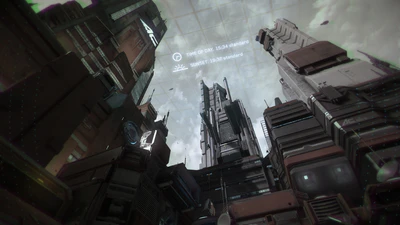
"Compact and light, it comfortably attaches to your wrist. Easy to use, it augments your life everywhere, all the time. With a mobiGlas, transform the ordinary into microTechordinary! Like all microTech products, the new mobiGlas has stunning visual design that conjugates style, power and usability without compromises."
mobiGlas concept

As Chris Roberts put it: “I’ve charged the mobiGlas team with a very difficult task: creating a realistic interface that will help keep your affairs in order in an expansive galaxy that we hope players will further expand in unknown directions. It’s almost like building our own in-fiction operating system for an imagined future, and it’s very different task than building spaceships.”
And it’s exactly that! Our team is imagining an operating system from the ground up. It is incredibly challenging and satisfying!
Our first goal when we initially came up with the augmented reality feature was to integrate the game’s interface in-line with Chris Roberts’ vision for a fully immersive experience. Not only do the mG and all its functions fit in fiction, they come from the fiction. The hardware is built by the in-game mega corporation microTech, while the apps are developed by various fictional in-game developers. It’s important to us that you feel the personality of each developer when using its products.
Holding a series of apps made by different companies, they need to have their own branding. So like the rest of the universe, brands are created for every single one of them. This helps advance the idea of a living, breathing universe. Like today, everything has a brand. We want to put that forward in every aspect of the mobiGlas. If you enter a shop, you might be tempted by its new arrivals, or a seasonal sale. No worries, it won’t be like the worst shopping websites you can imagine, far from it. No spam mail on your mobiGlas!
The mG is a device used by your character(s). NO gamey shenanigans. This is called diegetic interface, where what you see is the same as what the character(s) sees. This is really exciting to us, as we get to design an interface that is an integral part of the Star Citizen universe and not just an overlay that takes you out of the experience every time you use it. The augmented reality takes advantage of the high-definition environments, as interface elements are found in the 3D space amidst the game’s reality.
One of the biggest challenges when pushing for innovative interfaces is to make them intuitive. No matter how cool it looks, an interface is only as good as its simplicity to use. Obviously we’re keeping this in mind at all times. One thing you’ll notice when playing with the mobiGlas is that even though the device is set 900 years in the future, and looks like it, the flow and controls are based on what you know and use at the moment. We’re inspired by the real world’s best interfaces, taking the systems we like and giving them a new voice in the mG. We want to keep you in the comfort zone of current user interfaces, but still offer a far-future aspect.
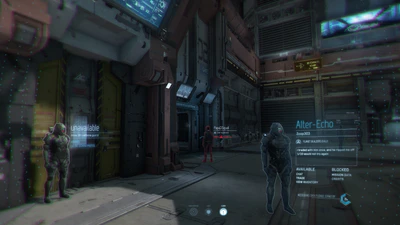
Augmented reality is a technology that is already available in our day and age. We wanted Star Citizen’s interface to be something more than a gimmick. It’s not just about the visuals; it’s about interconnecting every single feature of the game. The cool thing about what we’re designing is the fully contextual aspect of the interface. It adapts to your context, situation and position. The interface systems and the compatible entities found in the universe (practically anything) are interconnected, allowing us to link objects and characters to any relevant database and giving you fast access to the information you need. Aim at a character to know her affiliations; aim at a gun to get its market price in the current system; aim at a Consolidated Outland Mustang advertisement in the Terran subway to plan a route to the closest retailer. The uses are infinite and we intend to make the most of it.
The mG is an essential tool no matter your aspirations. It helps you track missions, review trades, plan routes and directly interact with the world in so many ways. It supports every gameplay role you can imagine. Not just a replacement for traditional menus, it is a tool in combat, space and planetary exploration, mining, scavenging, role-playing and more.
I’m sure by now you’ve gotten the point: your personal mobiGlas will be your best companion throughout your adventures in the ’verse, and we’re incredibly proud and excited to be working on it.
mG visuals
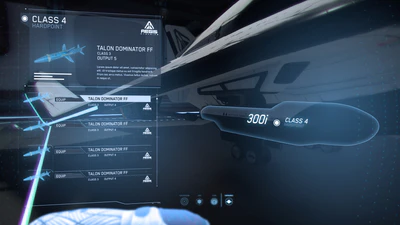
The first thing we’d like to clarify is that the mG can show 2D and 3D information (text, panels, objects) in two concurrent ways: through augmented reality, using an AR display such as contact lenses, and through a holographic “screen” projected from your character’s forearm. It’s important to understand that this is not a choice — both AR and holo-screen interfaces are used at the same time to create the full experience.
On top of that, we intend to make the mobiGlas connect to external devices such as ships and screens in the environment. Imagine guild members in their hangar’s conference room seamlessly exchanging information by flicking it from their mG to a giant screen.
If we get a bit deeper in the visual style of how we are developing the mobiGlas, we based our initial concepts on the work done on the ship HUDs. Because they are part of the same universe, a mobiGlas needs to feel familiar to ship pilots. We took a lot of references from sci-fi movies that utilize a futuristic UI. We had to bring a lot of thought into them, because the style seen in those movies isn’t made to be used by a normal user. They are made to seem usable, when in reality complicated screens should display only the most pertinent information and clear user experience (UX) rules. We also looked at references in the video game world, such as the Dead Space series, one of the best examples of diegetic UI. They had a different challenge though, being a (mostly) single player game with a 3rd person camera.
A key part of this FUI (fictional user interface) style is having clear shapes, mostly geometric. Also important is a strong use of straight pixel lines. Since the menus are floating screens, we are using solid color backgrounds to help separate sections visually. We used just a few colors, with strong complementary accent colors as the main visual scheme. Mainly, blue is the general color used throughout the mG screens. Blue is the culturally recognized color for holographic effects; using this helps place Star Citizen in the classic sci-fi realm. To feature light effects, most of the text is white or a paler color from the background. We are already blurring the background and putting in a subtle color filter to help legibility.
The base model mobiGlas is a holo-projector on your wrist that projects a layered series of grids above it. In that sense, our visuals all rest on a grid system. The device creates a projected cube, and the mobiGlas screens are spawned inside. The grid system is then reflected on the general layout of screens.
Fully diegetic
What I find exceptionally amazing about the mG is the fact that it exists 100% in the game world. As opposed to the AR interface that you can only see through a contact lens, the holographic screen projected from your forearm can be seen by the other characters as well. This allows us to create powerful immersive scenarios: Imagine exchanging information by showing your mG to another character, or at the opposite extreme, spying on someone else’s mobiGlas to steal sensitive information.
Some establishment might jam or block your mG to avoid scanning patrons. Try bounty hunting in these locations without the ability to get the names and IDs of people around! We always keep in mind the in-fiction parameters on how the mobiGlas screen system and augmented reality lens would work. We want to bring immersion and gameplay even into the menu systems.
Interconnection
Probably the most important thing to understand about the mobiGlas is that it is connected with practically every other component in the universe, from player characters to Takuetsu ship models. Thanks to the TAG system, which we’ll explain further another time, the mobiGlas can fetch data on anything that has been tagged, and interpret it depending on the situation.
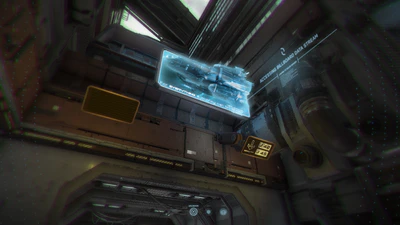
Through AR or through the holographic screen, you are able to collect information and cross-reference it. You can interact with the world and use it as a shortcut to a relevant app and its data. For example, while visiting planet X, you see a big billboard showing off a video commercial for a ship sale at Astro-Armada. You activate your mG AR mode to discover various holographic “buttons” floating right there beside the billboard. From here you can activate mG.compass, an app that shows you the way to Astro-Armada (think GPS), access the galactapedia network to get more information on the ship, or compare the ship stats with one of yours through mG.shipWorks. So many possibilities.
With such a wide and broad game universe the ability to connect game components through the various apps for comparison and specialised information is critical. Mastering this functionality will give you the edge in many fields.
New Technologies
The mobiGlas interface is being developed so that it can be used and reused with different hardware. The Oculus VR is definitely a device that makes the mobiGlas look particularly stunning. It brings you close and personal with your mG device, putting an emphasis on the parallax effects of the holo-projector screens.
Even closer to our reality is the reuse of interface elements on your tablet or other mobile device. The idea is that the Star Citizen companion app is your character’s mobiGlas wrist device (kinda old-gen though!). The visuals would be the same as in the game, but more importantly, the functions and data would cross from the PC to the tablet and vice versa for one seamless experience.
The mobiGlas device
Structure
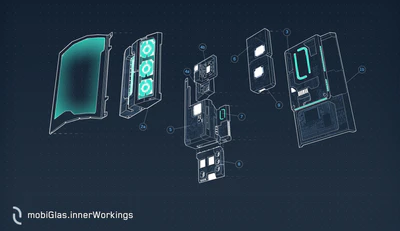
The mobiGlas is a forearm mounted electronic device capable of projecting a holographic interface and render an augmented reality interface through any AR display, such as contact lenses, glasses, visors or screens. It is developed by microTech, a corporation specializing in electronics, based in the Stanton System. The mobiGlas is now used in a wide range of fields, both civilian and military. Here is a breakdown of the mobiGlas main components:
| -Wrist mounted case | Physical part of the device, solidly attached to the wrist. Fits most space suits and civilian clothing, or can be attached directly to the arm. |
| -Universal mobiGlas Connector (UMC) | The male part of the UMC. |
| -Holographic Projector | Made from a super resistant glas lens, the projector sits in a protected crease on top of the wrist case. |
| -Holographic Screen | Counts as a component even though it’s not physical. The layered screen is entirely holographic. 3D holographic objects can be projected, as well as flat (screen) holograms. |
| -Back Panel | While you see the main interface on one side of the holographic screen, the other side is displaying something else, an opaque image for example. |
| -Biometric Battery | This component feeds your device with power and monitors your vitals for security reasons. |
| -Primary Scanner port | The mobiGlas comes with the default MT.Scanner, used to get info about your surroundings. It is a short range multifunction scanner. Can be upgraded. |
| -Specialized Scanner Port | An opened slot ready for custom specialised scanners. |
| -Data Drive | This is where data is stored. The data drive is synced on the user’s genetic signature and shuts down or is destroyed if it loses contact with the user. |
| -Intra-System Comm. Card | For intra-system communication. The comm. Card can be changed for specific needs. |
| -Power Chip | The P79xx is the most powerful chip yet used in a personal device. Its technology is based on microTech’s high-end experience on ships’ electronic components. |
| -Chip slots | Open slots to insert augment chips. There is a large collection of chips, mostly by microTech but also by other developers. |
| -Wireless Emitter | This is to be connected and synced to any ship, power suit, environmental suits or power armor equipped with an AR display visor or other compatible devices. |
| -Optional Armor Cover Add-on | To protect the mobiGlas from hazards. |
mobiGlas series
As mentioned earlier in this article, Star Citizen’s interface is another chance for us to expand on the fiction. The mobiGlas, as we present it, is but the first and most widely used model of intelligent device you’ll be able to own in the PU and in SQ42. Just like ships, we aim at building various models and series of mobiGlas-like devices. Don’t be surprised if a competitor to microTech appears with their own intelligent devices introducing the type of competition we see among mobile devices today!
Different generations of mobiGlas would present different functionalities, performance and capacity. The goal here is not to limit some models but rather give a wider array of functions to some models versus less varied but more specialised functions in others. For example, the UEE navy mG and the Advocacy mG are special models built for those organizations with specific apps, functionalities and access rights.
Obviously different models have different aesthetics even in the same series. The visuals of the physical device and the interface style would be custom for each model. “Princess Glitter Pink” mobiGlas was the fad in 2942 you know. ;)
You can modify or change your mobiGlas for another model as long as you can afford it and can find the model you want. Some are rare! mobiGlas, mobiGlas S, mobiGlas+ ? The first models available in the PU are the standard mG and the exploration mG, which was awarded to all backers before the “42 million” pledge goal:

"Explorer-class mobiGlas Rig – Every player who backed before we hit $42 million will start the game with their own, visually distinctive mobiGlas “ExoGlas” rig which can be used to access the Observist at any time. This backer-exclusive mobiGlas kit comes pre-loaded with additional galactic information that new players would ordinarily need to explore or barter to fill out; it’s our way of honoring the information you’ve collected about the Star Citizen universe through the RSI site and community over the past year!"
Add-ons, chips, apps & hacks
Just like many other components in Star Citizen, we want you to be able to have a lot of choice when it comes to customizing your experience. The mobiGlas is no exception, from shady corners of the universe to top notch UEE computer science laboratories; you’ll find experts that can alter and tweak the standard mobiGlas.
Upgrading brings new or enhanced functionalities to the mG, and sometimes at a cost, either monetary or worse … try to stay legit, Citizens, or you might lose an arm in the process!
Add-Ons are physical devices clipped to or inserted in the mobiGlas case. They range from specialized scanners to shielding shells. The most diverse add-ons on the market are called augment chips. These little pieces of hardware contain code and sequences that enhance functionalities into advanced, specialized tools.
Last but not least, you’ll have a variety of apps to choose from. As you might have guessed, apps are software that are either part of the basic mobiGlas package or bought (with UEC) and downloaded from the mobiSTORE. We aim at providing many apps to choose from, that present similar content but in different ways. Beyond the basic packages, these extra apps might feature specialized content that are great for some of you and near useless for others. It’ll be up to you to find and make best use of your favorite apps.
Functionality groups
The mobiGlas is a very complex device that features many possible functionalities. To help organize them and interpret them in various game systems, such as damage states, they have been classified in four functionality groups:
| Group.A | Essential Functions: These functions are at the very foundation of the mobiGlas. They are critical to the mG experience and to the core game components. These functionalities appear no matter what, even in an extremely damaged or cheap version of the mobiGlas. A good example of an essential function is the ability to access your communication availability options. |
| Group.B | Advanced Functions: These functionalities are part of the core design of the mobiGlas but are not essential. They usually are more specific to a particular system, and if they don’t appear in a model or get disabled, you could manage without them. An example of an advanced feature is the planetside map and radar functions. |
| Group.C | Specialized Functions: These super advanced features are to be used in very specific cases for specific character profiles. They are usually linked to chip add-ons or special models. For example, a biometric scanner is a Group.C function. |
| Group.D | Extra Functions: Extra functions are inconsequential to gameplay. For example, these include themes and styles. In case of a damaged mobiGlas, the system cuts off Group.D functions in order to prevent further damage from unnecessary functions. |
Damage
Like pretty much any item, the mobiGlas is not impervious to damage. The mG damage level follows the left lower arm damage status as explained by [REDACTED]-illfonic in the “Design: Healing Your Spacemen” article.
- Normal: In its normal state, the mobiGlas features are all working perfectly. Smile.
- Hurt: In the hurt state, some functions are disabled and glitches can be experienced in the interface. Some Group.B functionalities are disabled. Group.C functionalities are mostly disabled.
- Damaged: In damaged state, the advanced features (Group.C) such as the chip add-ons and the scanners cannot be used at all. Furthermore, the mobiGlas interface becomes very glitchy. Even more Group.B features are disabled.
- Ruined: In ruined state, non-essential mobiGlas features are practically useless. Frequent glitches make it harder to use.
Glitched interface
When damaged, you’ll experience visual glitches with the mG and its AR display. The goal here is not to make your lives difficult when trying to interact with the interface, but just to dress it up and offer a fun challenge. Effects such as phasing, displacement and color inversions could be used sporadically to illustrate a glitched interface.
For example, the words on screen could phase and be displaced. Large chunks of pixels could move around or stay stuck to the screen until the next refresh. Portions of the screen could have inverted colors.
“Ranges” or “AR zones” are used to know if an object looked at through the mobiGlas AR display should be shown and if it can be interacted with. They are custom per object, relative to their size, position and context. For example, massive objects such as billboards or capital ships have mid and long range zones that go much much further than the ranges of a Thorshu Grey! All objects that are interactive with the mobiGlas have a range and angle of interaction. In order to interact with the object you must aim at it, be close enough and see it clearly on the screen. This avoids any confusion or conflicting selections. Here’s a quick breakdown of the interface zones used by the mG:

- A-Holo-Screen: The projected holographic screen takes 95% of the player’s display space when open. The main screen is where the bulk of interactions are made in the mobiGlas and the main medium for on-screen interface. In case the players have no AR display devices, it can be used as the “window frame” to the augmented reality.
- B-Extended Holo-Screen: Some apps necessitate an extended, panoramic view.
- C-Close Range AR: In AR, objects seen in their close range usually display low to no information as they are too close to render properly or to be read properly. In some situations a special icon tells the player the object is too close.
Being too close (zone c) to an object makes it unselectable. This is to ease the selection of components within other components (e.g. a shot of whiskey on a table). The table itself is too close to be selected, making it easier to select the shot glass. - D-Mid Range AR: In AR, this zone is the sweet spot where an object’s full AR information and interactions are available. When the object stands inside the mid range, the object shows that it is selectable. At this range, the player can select and interact with the object.
- E-Far Range AR: In AR, objects in their far range appear and show minimal information. The far range objects’ information and feedback are disabled when mid range objects are in front of them. In some contexts, long ranges can be infinite.
Using the mobiGlas
"Your day starts with putting in your AR contacts, or AR display glasses, which automatically connect to your mG. Following a quick boot-up sequence the augmented reality interface is displayed. Now you have access to a massive amount of meta-data found in the world just by looking at things around you."
You’ll be using the mobiGlas in practically every context. Considering that all citizens are allocated a mobiGlas, it’s everybody’s personal assistant device, as ubiquitous as smart phones are today, if not more!
As it connects to all sorts of things around you, it syncs pertinent information contextual to your situation. Whether you’re reading the planetary news while taking it easy at Café Mussain or reviewing your ship’s armor status whilst in the heat of battle, the mobiGlas apps are tailored for a wide array of gameplay situations.
The AR interface is very powerful and intuitive, offering an experience closer to reality, while putting traditional interfaces in a coherent, in-fiction context. When shopping at a location, rather than getting a big scroll list of items for sale as in a traditional game interface, your shopping is done via AR overlaying actual, physical items. AR is dynamic; the interface shown in the world is filtered based on several factors such as your location. For example, while entering a shop like Cubby Blast on ArcCorp, your display shows off a connecting icon and boots the mG.easyShop app AR interface. In this context, items available for purchase are shown and highlighted right there in the world, with the addition of AR labels showing you the prices and specs of these items.
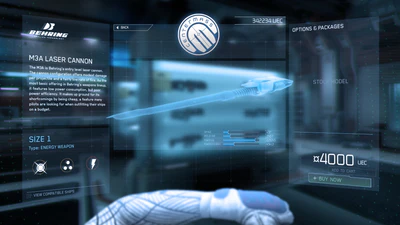
The idea is that your mobiGlas device is constantly linking to local servers for information depending on the location (so each store serves up specific local data that your AR interface can display). At any time you can choose to change the AR filter to another mode to be able to access other type of information. For example, while still in that same shop, you could switch to the exploration filter which shows AR labels for players’ information such as player handle, bounty, etc.
The mobiGlas wrist device is used for entering commands and to display objects or extra panels projected from the holo-projector. Some apps use only the holo-screen, while others rely heavily on AR. The holo-projector is similar to the ship HUD in the sense that it uses 3D objects in combination with panels and text to give you the right information.
"Forget about the old ways of touching a screen. The mobiGlas finally replaces the 900-year-old technology with an ultra-precise portable holographic interface. With the Holographic Augmented interface, project critical information directly in your reality with unprecedented clarity. What you see around and over real objects and persons becomes interactive; you can literally touch the meta-data."
Moving things around
Where it gets interesting is with the advanced uses of AR in combination with the attached wrist holo-projector. For example, you can take and move objects around in AR for various reasons. While shopping, you can “pick up” the AR version of a shelved object, effectively creating a new AR object with following labels that you could keep “on the side” for quick comparison with other products elsewhere in the shop.
The same goes for mG.shipWorks, an app allowing you to customize ship loadouts directly on your ship, using holographic representations of ship components which can be “grabbed” and moved around.
Augmented reality
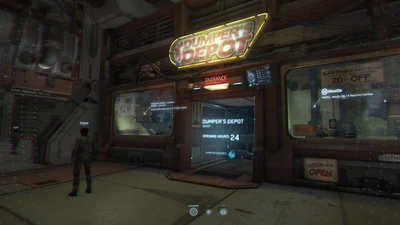
The real power of the mobiGlas comes from its augmented reality interface. Since AR requires more exploration and explanation we decided to share more information on that mode. The system is quite simple in theory: 3D Interface objects are placed directly in what you see instead of flat on your screen.
As you might have guessed, implementing an AR interface is easier said than done. Various systems must be put in place to make sure the information and interactions are well interpreted and easy to use, avoiding frustrations. I know I’ve rage-quit games because of appalling user-experiences; how about you?
AR objects
AR objects are what appear in the AR display. There are several categories of these special objects:
Enhanced entities
Enhanced entities are real world objects or life forms with an added effect such as outline, lighting or shader seen through the AR display. The objects are part of the environment. They move, act and collide normally. Enhanced entities have short, mid and long range values, and states that alter their appearance.
Holographic objects
Holographic objects have very similar rules to enhanced entities, but are not real and thus have no collision. They are attributed a special material that makes them invisible by default but visible while looked at through the mobiGlas. Like enhanced entities, they have short, mid and long range values, and states that alter their appearance. Navigational icons and signage are notable holographic objects that appear only in augmented reality to avoid cluttering some of the more pristine areas of the universe.
AR labels
AR label, or “larbels” as we like to call ’em, are 2D panels placed in the 3D world. Labels are used to view additional information and data about objects found in the environment, such as prices, descriptions, names, etc. They vary in style, shape and form, depending on their location and use.
AR labels are either always there; appearing when in long, mid or short range; or appearing when in focus. This is defined per label. On top of all this, labels can update and expand with more information the more attention you give the related object.
AR object status
AR objects, no matter what type they are, appear differently depending on the range at which they are viewed and the state they are in.
| [Out of Range – Long] | When an object is further away than its long range zone, it is invisible, even through the AR display. |
| [Out of Range – Short] | Objects that are too close are out of range. They cannot be selected. |
| [Idle] | AR objects are idle when seen at a long range. An idle object can be seen through the mobiGlas but cannot be interacted with or even selected. The highlight or holographic object should be dim. |
| [Selectable] | Every AR object seen through the mobiGlas in mid range is in a selectable state. Selectable objects have brighter highlights and the holographic objects are almost opaque. |
| [Selected] | When you focus on a selectable AR object with the mobiGlas it becomes selected. A selected object’s highlight becomes very bright and animated to clearly show what is selected. |
AR object limitations
AR information can be blocked or altered in many ways and for various reasons. Here are the various status names and descriptions.
| [Altered] | The mobiGlas can be hacked to display deceitful information. Altered labels are hard to detect without proper equipment and appear as legit labels with altered information. |
| [Blocked] | Blocked information is made unavailable by the user who owns the information. This is done in multiple ways using mobiGlas advanced features like jammers. Blocked labels don’t appear at all or show the following label: [UNAVAILABLE]. |
| [Contextual] | Contextual labels only appear to a user who’s in the right context to see them or needs the information at the moment based on the context. For example, to normal folks, bounties only appear if they currently own the bounty contract, but to a licensed bounty hunter with the appropriate app, all bounties are visible. |
| [Restricted] | Only members of the same faction as the restricted object/player and of a clearance level equal to or higher than the restricted level can get this data. Everyone else gets the following label: [RESTRICTED]. |
| [Unavailable] | Sometime there is no data available for the label to show. In those cases, the label doesn’t appear at all or displays the following: [UNAVAILABLE]. |
AR basic controls
Maybe you are wondering if AR is something that would always be there, ALL the time. The answer is no. AR is necessary to access a lot of information and features but doesn’t have to be ON all the time. You decide what your experience should be. While the AR display is off, some objects can be interacted with that automatically opens the mobiGlas’ AR display with the relevant filter ON.
Moving in AR mode
While in AR mode, you can move freely, even though you need to be in first-person view to see the AR interface. There is no restriction on the type of movement you can do with the AR vision ON. For example, walking, running, crawling and horseback riding are all super cool in AR.
Selecting/interacting
AR objects sometime have complex interactions. To access those interactions, you must select the object first. To select an AR object, you just have to walk in the mid range of the selectable item and center your view on it. This is called focusing. When selected, the object is highlighted in the 3D space with a very bright holographic outline. To start interacting with the object and accessing all its options, hit the accept/action button.
Changing filter mode
It’s possible to cycle between the various filtering modes (more on that later) by using a set of buttons yet to be determined. It is also possible to access a specific filtering mode automatically and contextually by focusing on an object, by entering a world area tagged with a filter type, or by interacting with filter boxes.
Moving AR objects
One powerful thing the AR mode can do is let you move holographic objects around. This is done automatically in some modes, such as with the hangar customization furniture placement. The controls are similar as “holding” an object in most FPS games. The object stays centered in the screen except if it collides with environmental boundaries or anchor points.
We soon realised that with so many AR objects in the world, the environment would be quickly cluttered with interface items, which is something we wanted to avoid for readability. This brings us to:
AR filters
There are so many interactive items available in the world that we decided to add a filtering system to focus on the objects you are interested in at the moment. While your AR display is ON, you can switch filtering modes at will. Each filter shows different categories of AR objects. Some filter modes use a combination of categories. We might even let you create your own filters at some point.
Practically any app found in the mG has its own AR filter. Here is list of filter examples:
| Exploration mode | This is the most global AR filter there is, and is the default filter. With the exploration filter, every AR object is shown. When an AR object has additional information that would appear in a different filter, that additional information is indicated by a specialty filter icon, allowing you to switch to that particular mode in order to display the info. Interacting with AR objects in exploration mode switches the AR filter to the correct specialty filter automatically. |
| AR.easyShop | Syncs with shops and other mobiGlas devices that are broadcasting items for sale. Your mobiGlas shows AR information for any object that can be bought or traded. |
| AR.shipWorks | Focuses on any shipWorks AR objects available, such as ships and ship components. |
| AR.hangarService | Focuses on room customization. Shows anchor points and customization grids, and highlights movable objects. |
| Others | This filtering list is forever expandable. Upgrades, mods and hacks can potentially add new filtering modes as well. |
Auto-filter focus
To ease the use of AR mode and limit the amount of button pushes necessary to get information from it, the filters are set automatically, based on the object viewed prior to opening the AR mode. For example, while you’re walking around Casaba Outlet (a clothing store) and looking at cool jackets, when you activate the mobiGlas AR vision, the system interprets that the current focus is a coat in a shop and thus switches to the shopping filter automatically.
Auto-filter area
Opening the AR mode in auto-filter areas activates the corresponding filter automatically. That said, it does NOT force you into using that specific filter; you can always switch to another. Note that the Auto-Filter Focus has a higher priority than the Auto-Filter Area. For example, a character enters Dumper’s Depot and opens the mobiGlas in AR. The AR automatically sets itself to the Shopping Filter since Dumper’s is a shop.
Filter icon
Filter boxes are AR objects that show a specific object has additional AR functions in another filter than the one selected at the moment. For example, while in Exploration filter in your hangar, while looking at an expansion door you’ll spot an AR hangarService filter box. Selecting the box in mid-range switches the AR filter to the corresponding type.
Augmented object tags
Augmented information found in the world is tagged with content type using the TAG system. This is used to filter what is to be shown in the various modes of the mobiGlas.
AR targeting system
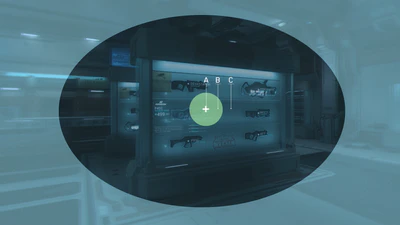
The AR Mode aiming reticule has 3 components: the soft selection circle©, a locked selection (B) and the cross-aim (A). The aiming reticle does not show, but is a visual representation in the illustration below of the center of the focus zones.
| A-Cross-Aim | Even though invisible, the cross aim is always centered in the screen and in the soft selection circle ©. The cross is used to aim at objects in the world. When aiming at something for a short time, it becomes a locked selection. Items under the cross-aim (centered on screen) become brightly highlighted, displaying a special AR visual treatment and detailed additional information. |
| B-Locked Selection | When an object is a locked selection, the outline of the object becomes brightly highlighted. If, by object movement or your movement, the locked selection exits the soft selection circle by 50% or more, the object is automatically unselected and the bright highlight disappears. While in this state, you can interact with the object. Any items inside the soft focus area get softly highlighted and some additional information is displayed. |
| C-Soft Selection Circle | This large circle defines the area where the locked selection can move without AR information being lost. When the locked selection exits the soft selection by more than 50% of its total area, the object is unselected automatically. The soft focus circle is static in location and size. All other items, which are not inside the soft focus area, show only their anchor icon and name. |
Other AR systems
Focus system
The focus is how much attention is given to an AR object. This is measured by how much time you look/aim at an object in the world. As your focus is prolonged on an item, its labels will expand and display more information about the object.
Layer system
In terms of aiming, the mobiGlas interprets what is aimed at by using the ordering of what is seen. So for example, looking at a coffee mug on a desk, the coffee mug is on top of the desk so it is prioritized.
Density system
When multiple objects are cluttered at the same spot, you are able to move the cross-aim slightly to switch between the different objects. The system cycles between the various items that are in the same general area.
Labels appear relative to density. The aimed-at or locked object information appears in priority, while the rest appear only if the current label density is judged acceptable for readability.
mobiGlas apps
You might have been wondering exactly what kind of apps you can expect to find in the mobiGlas. As a last treat, we’d like to share with you short descriptions of some of the apps we’re currently developing.
MG.HOME
HOME is your hub; it’s from this customizable menu that you’ll access the rest of the mobiGlas content. Being an operating system holding various apps, the home page will have a dynamic app layout to facilitate your experience.
Mainly, HOME is a portal to the other applications that it displays with branded icons. The app selection is contextual to the current situation, featuring content that makes the most sense to you at that moment. Favorite applications and recently used applications are also found on this screen. HOME analyzes what apps you’ll likely need to see and offers quick links to them.
HOME is built with widgets that can be modified and rearranged to fit your play style. You choose which information shows up where and in how much depth this information goes. For example, I keep my alertCenter widget handy in HOME to have a glimpse at any notifications that came in recently. The news and economic data widgets are also very useful to see what kind of contract could be available in the neighboring systems.
The more you use your mobiGlas and customize HOME to fit your needs, the more accurate and efficient you’ll be.
MG.ALERTCENTER
This app is exactly what it sounds like. Anytime any of your apps receive new data, for example when you receive a contract update or a hangar invitation, you will receive a notification, which appears in the alert queue of alertCenter. Notifications also appear in a dedicated section of your AR display. That way, you’re always notified when something important happens, no matter your situation.
alertCenter offers a slew of options to customize which event should appear as a notification and when. Most of you are going to have busy, busy days in the Star Citizen universe! Use alertCenter and never miss anything.
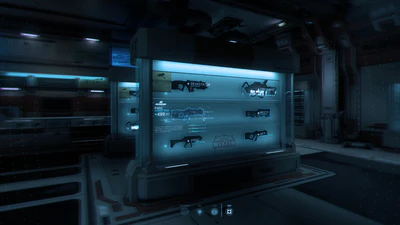
MG.EASYSHOP
EasyShop is the mobiGlas application that allows you to buy and sell things, from ships to handkerchiefs. It is what links you to a store’s inventory and facilitates your shopping experience.
The shops in the persistent universe feature actual physical products that can be looked at and bought just as in a real world shop. To buy an item, you use the AR display with the shopping filter ON. The mobiGlas syncs with the broadcasted information of the shop to show data on shelved products.
While most shops takes advantage of the AR display, some stores choose to show their products via a catalog. easyShop is also a platform to access these catalogs. Catalogs are dynamic and feature beautiful holographic projections of products. They can be re-arranged, searched, sorted and filtered at your discretion.
MG.CARGOMANAGER
Simply put, cargoManager lets you search and manage your entire inventory. It consolidates every possible cargo you might have: hangar warehouse, ship cargo, pants pockets, etc., and categorises them into a database.
It allows you to access your entire inventory from ship to weapons, from hangar to resources. It is like an encyclopedia of your possessions. Therefore, it provides the tools needed to track, compare and manage your possessions, guiding you towards informed decisions.
MG.CONTACTS
The contacts directory is the complete repository of the contactable entities you have met, collected from the persistent universe or added manually. Primarily, it allows you to find, add, remove, ignore and block other Characters. Other functionalities, such as grouping, search options and filters, allow you to find, organize and manage your contacts. Contact entries include players, NPCs, planets, corporations, orgs and so on.
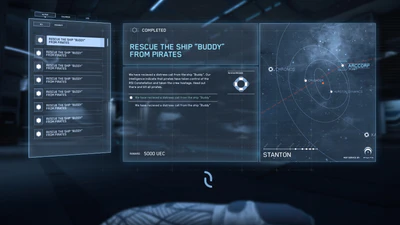
MG.SCHEDULER
mG.scheduler is a planning application. Missions, contracts and special events are automatically or manually entered and tracked by scheduler. It allows you to quickly get information about important events such as starting/end date, who issued a contract, what’s the goal, a backlog of conversations and so on.
Mundane events such as appointments and shipping estimates can be automatically entered as well. You can enter your own notes and events or sync with the scheduler of a particular individual or org. Adding custom events, reminders and appointments to the scheduler is a breeze. Enter the name of your event, a starting and end date, along with an optional location and contact label, and move on to your next task.
The scheduler is the go-to app to plan ahead and stay at the top of your game. Important events, urgent missions and critical deadlines are clearly identified. Filtering options allow you to see what is relevant to you at this moment. The scheduler automatically warns you of upcoming events and milestones, with reminders of varying degrees of urgency. Never miss a contract deadline or your mother’s birthday ever again.
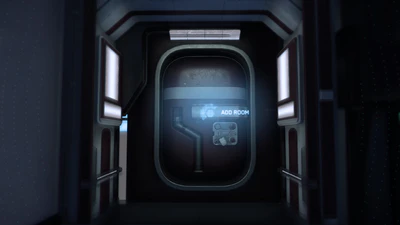
MG.HANGARSERVICE
Your Hangar customization and upgrades are done through the mobiGlas by interacting with AR objects through the hangarService, an app designed to access hangar-specific functions. hangarService is provided by your hangar manufacturer to expand your hangar, customize your living quarters, purchase specialty rooms, design your interiors, change your hangar access rights, modify your ships’ placement, and more.
MG.SHIPWORKS
shipWorks is akin to the holo-table, but with added functionality that allows you to interact with your ships in augmented reality. It is an engineering app. shipWorks allows you to easily search ship components in your inventory or equipped on a ship. With the smart sort and filter features, compare similar assets to make a strategic choice and customize your ship with the perfect load-outs.
Get direct access to repair, refuel and re-arm options, tag parts of ships to be serviced, and review power management configurations and cargo space before taking off to the dangers of space travel. Get a full statistical report on your ship. Analyze the damage state of your ship’s individual parts and hull.

MG.SKYLINE
mG skyLine is the mobiGlas version of the galactic map directory and navigation planner found in ships. It features a full-blown star map to find your way around the known galaxy and its myriad of systems.
skyLine’s strength comes from its ability to be synced with other apps for dynamic information, such as market data, pirate sightings, tourist must-sees and much more. It’s a NavMap++. It’s a complete atlas, “GPS” and repository of your planetary and galactic data.
CCB FINANCE
CCB Finance app is everything about finance, economy and money. You can review your transactions (old and pending), review the market data and see your current balance. You have access to the data needed to analyze the economy. Link CCB Finance to the AR display to get market data on what you are looking at.
AND MORE
mG.handShake helps you to create contracts with the aid of templates; mG.sleeve is your collection of passports, licences and other official “papers”; mG.spectrumGate grants you access to the spectrum and the galactapedia; mG.smartTrade simplifies trading with other players. These are the first applications that will be found in the mobiGlas.
Next steps
As with any game, we can only get to a perfect result by testing it in its real context. The next steps, as features planned for Star Citizen become real, are to build, test and polish the mobiGlas, and to give you access to those features in an easy and intuitive way while staying true to the fiction.
With our internal tests, team of experts and your feedback, we can make the mobiGlas experience a fantastic one.
The next steps we have in mind are to:
- Give you access to the mobiGlas to get your feedback. User testing is the only way to make a user interface near perfect.
- Push the visuals. There are all sorts of little tricks to make the AR interface sit in the world in a believable way, but these little tricks necessitate a great deal of effort.
- Create more apps and iterate on the first handful of functionalities already in the game as they become available to you.
We hope that once you get your hands on the mobiGlas you will find the experience pleasing even though, in the beginning, it will be far from the high-level vision we have for it. Until then, enjoy the game and see you in the ’verse!
End transmission
DISCLAIMER: As with any design post, this article represents our current thinking for the systems covered. All content is subject to change as a result of testing. The numbers provided here represent data that is current as of publication, but which will likely be altered in a number of ways before launch to create the best possible Star Citizen experience.